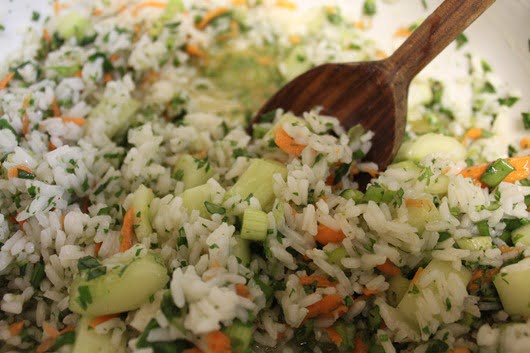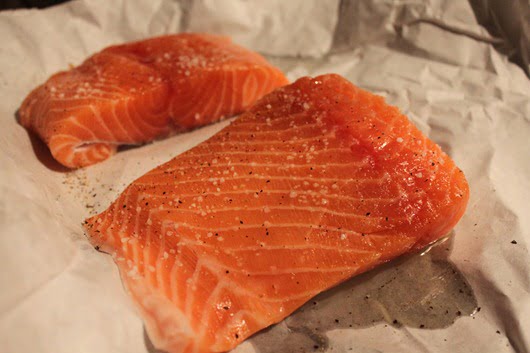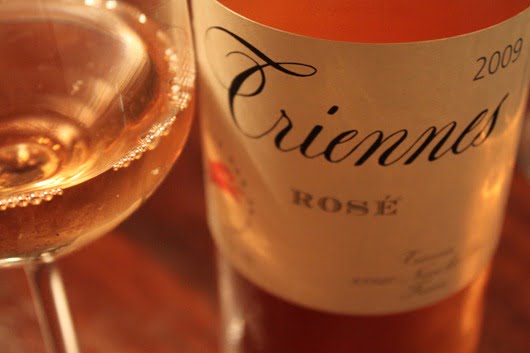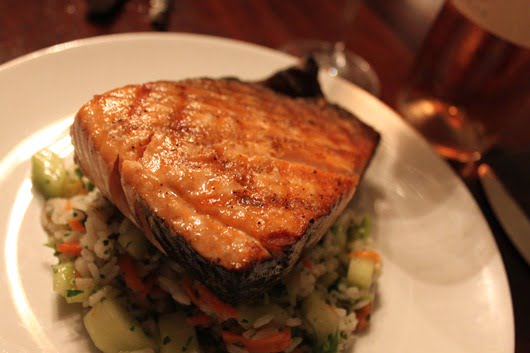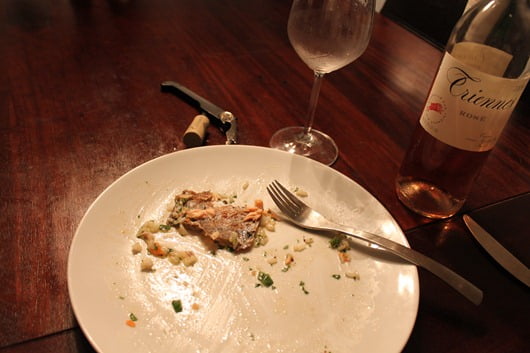Salmon with Thai Rice Salad Paired with Triennes Provence Rose
April 25, 2011
I’ve been trying to convince Mrs. Chislett to eat more Salmon, I personally LOVE IT, but for some reason she has always had an aversion to it. Maybe it’s an English thing on my part! Salmon seems to be a much more prevalent menu item over there!
I actually chose the wine first for this pairing, and then selected the recipe to match. The Triennes Provence Rose is a joint project between Michel Macaux and Aubert de Villaine, yes THE Aubert de Villaine of Domaine de Romanee Conti fame (for all you wine nerds out there).
The wine is made from Cinsault [SaN-so], a grape which you don’t tend to see too much in unblended form. It’s heavily planted in Southern France, and was famously crossed with Pinot Noir to create the South African Pinotage grape variety.
Provence is a wine region located in the far South-Eastern part of France, and is best known for roses, its warm climate, and wines which generally represent great value for money.
I was very happy with this recipe for Salmon with Thai Rice Salad. Very simple to make (3 step method), plus I got to use the Asian Fish Sauce again which I purchased for last weeks recipe!
I was a little worried that the rice would be a little bland, but it turned out that wasn’t the case at all, with the cilantro (my favorite herb) really shining through.
I tend not to cook with rice too often, probably even less now that I just recently put myself on a low-carb diet, but this Thai Rice Salad was actually pretty impressive for such a quick meal!
The recipe calls for putting the salmon on the broiler; but since I have never been one for being told what to do, I put the salmon on the grill instead (skin on). I’m all-about using my outdoor grill for as much cooking as possible during the warmer months! Very little clean-up, and a taste that far exceeds anything cooked on an indoor grill.
The Triennes Provence Rose showed delicate raspberry, cherry and watermelon flavors, with peach sorbet, white flowers, bracing acidity and minerality, and a surprisingly lengthy finish.
$13.99 average retail is a bargain, although I wouldn’t expect to see the wine around too much, which is a shame really!
Rose wines really do have an identity crisis. The Triennes was obviously a million miles away from White Zin, but when people see a pink colored wine, that’s exactly what they are expecting. Plus if you’re a guy, I can see why many don’t touch rose. It’s quite hard to look manly whilst drinking a pink colored wine! Personally I have also always said that it’s also quite hard to look manly whilst eating a banana, but I digress…!
I’m still waiting for rose wines to get their day. Each year, they inevitably always do a feature on them in the major wine mag’s once the weather starts warming up, with some headline which states that “…this year they are going to be the next big thing!”. However roses have still yet to fully take-off in the U.S. (at least from what I see). Saying all of that, the Triennes is a perfect rose to pickup if you are looking for a game-changing “pink wine”!
So on to the pairing! This should have been an easy one, at least in my mind!
I’m still not exactly sure why this didn’t work out, but the pairing was…well…just ok. Nothing special. Even though the wine was relatively subtle in character, I felt it did actually overpower the dish. Kind of hard to believe I know since I wouldn’t exactly describe this as a full-bodied rose.
If I was going to attempt this again, I would probably opt for an even lighter bodied rose, but still from the South of France. Maybe a Lirac. Thinking about it; maybe it was the Cinsault in the Triennes which was the problem?
Now don’t get me wrong, both the wine and the recipe were well above my expectations, in-fact don’t be surprised if you see this recipe being given another feature, since it was so simple! It’s just that putting the two together on this occasion didn’t exactly “float my boat”.
I’ll therefore rate this pairing as:
Neutral
~ My Food & Wine Pairing Guide ~
Bad Match
The interaction of wine and food when tasted together has a negative impact on the senses. This is common when the food item is high in acidity, salt, bitterness, or spiciness.
Refreshment
Many times wine serves simply as a satisfying refreshment to accompany a certain food choice. The refreshment match may be appropriate when the food severely inhibits a good or synergistic wine choice.
Neutral
These pairing situations are average and pleasant, but are missing an element of individuality and thus cannot provide a superior gastronomic experience.
Good Match
In this situation, you have found a wine that matches the food item’s basic components (sweet, sour, bitter, salty) and overall body.
Perfect Match
This essentially means the combined effect of the wine and the food paired together is superior to the sum of the individual parts.
This entry was posted in Pairings and tagged Aubert de Villaine, Cinsault, DRC, France, Provence, Recipe, Salmon. Bookmark the permalink. ← 2nd Annual RiverHops Benefiting North Florida School of Special Education TAG Cinco de Mayo Block Party →
